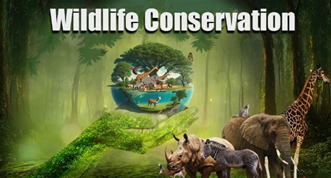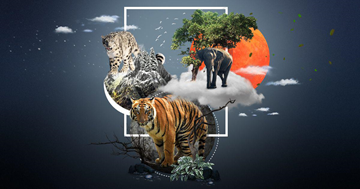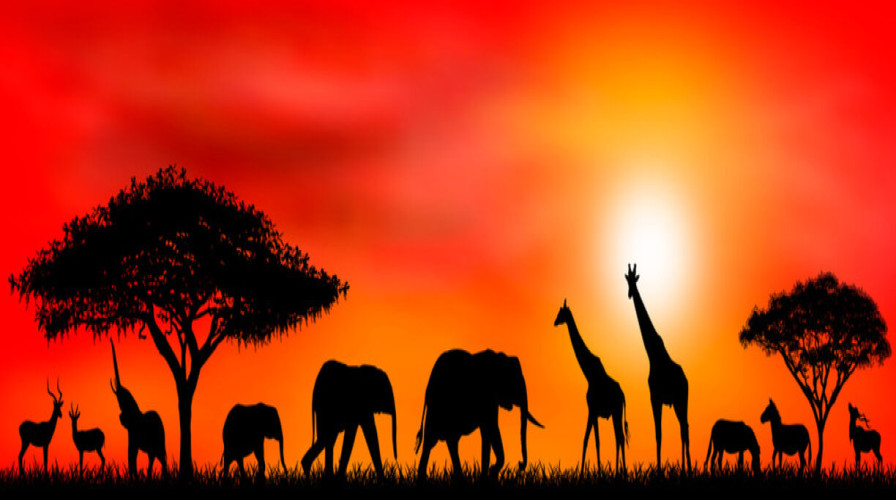Challenges in Wildlife Conservation:

Wildlife conservation in India faces numerous challenges, stemming from various factors that threaten the country's diverse flora and fauna. Here are some key challenges:
Habitat Loss and Fragmentation: Rapid urbanization, industrialization, agriculture expansion, and infrastructure development lead to significant habitat loss and fragmentation. This diminishes available habitats for wildlife, reducing their populations and increasing human-wildlife conflicts.
Poaching and Illegal Wildlife Trade: Poaching remains a severe threat, driven by demand for wildlife products such as ivory, tiger bones, and exotic pets. Despite stringent laws, poaching networks persist, exploiting vulnerabilities in enforcement and border control.
Human-Wildlife Conflict: As human populations expand into wildlife habitats, conflicts arise over resources like water and grazing lands. Crop raiding by elephants, predation on livestock by carnivores, and attacks on humans by wildlife are common issues, leading to negative perceptions and retaliatory killings.
Climate Change: Climate variability and change impact wildlife habitats and migration patterns. Shifts in temperature and precipitation alter ecosystems, affecting species' survival, reproduction, and food availability.
Invasive Species: Introduction of invasive species disrupts native ecosystems and threatens indigenous species. Invasive plants, animals, and diseases outcompete native species for resources, leading to biodiversity loss and habitat degradation.
Addressing these challenges requires integrated approaches, including policy reforms, community engagement, scientific research, and international cooperation. Effective conservation strategies must prioritize habitat preservation, wildlife protection, sustainable development, and awareness building to safeguard India's rich biodiversity for future generations.
Cultural and Ecological Significance:

India boasts a rich tapestry of cultural and ecological significance, intertwined through millennia of history and diverse landscapes. Here are some key aspects highlighting this significance:
Cultural Significance:
Religious Diversity and Sacred Sites: India is home to multiple religions, each contributing to a rich tapestry of sacred sites and rituals deeply connected to nature. For example, rivers like the Ganges are revered by Hindus, while mountains like the Himalayas are sacred to Buddhists and Hindus alike.
Traditional Knowledge and Practices: Indigenous communities across India possess traditional ecological knowledge passed down through generations. This includes practices in agriculture, herbal medicine, and sustainable resource management, reflecting a harmonious relationship with nature.
Arts and Festivals: India's cultural diversity is celebrated through vibrant arts, music, dance, and festivals that often reflect ecological themes. For instance, festivals like Pongal in South India honor agricultural abundance, while Diwali emphasizes the triumph of light over darkness and sustainable living.
Ecological Significance:
Biodiversity Hotspot: India is one of the world's biodiversity hotspots, hosting a staggering array of flora and fauna. From the dense rainforests of the Western Ghats to the high-altitude ecosystems of the Himalayas, India's landscapes support numerous endemic species and unique habitats.
Key Ecosystem Services: Indian ecosystems provide vital ecosystem services such as water purification, carbon sequestration, and climate regulation. Mangrove forests along the coastlines protect against storms and provide nurseries for marine life, while forests in the Himalayas regulate water flow to the plains.
Endangered Species Conservation: India is home to several endangered species like the Bengal tiger, Indian elephant, and Asiatic lion. Conservation efforts, such as Project Tiger and Project Elephant, underscore the country's commitment to preserving flagship species and their habitats.
India's cultural and ecological significance is a testament to its diverse heritage and commitment to harmonizing human activities with natural ecosystems. By recognizing and preserving this significance, India continues to play a crucial role in global biodiversity conservation and sustainable development.
Future Directions and Opportunities:

Looking ahead, India faces a pivotal moment in charting its future directions and seizing opportunities across various domains.
Sustainable Development Goals (SDGs) Integration:
Environmental Sustainability: Emphasizing sustainable practices across sectors like agriculture, industry, and urban planning to mitigate environmental degradation and promote resource efficiency.
Climate Action: Strengthening commitments to renewable energy, reducing carbon emissions, and adapting to climate change impacts through resilient infrastructure and sustainable land use.
Conservation and Biodiversity:
Enhanced Conservation Efforts: Scaling up efforts to protect endangered species, expand protected areas, and restore degraded ecosystems through collaborative partnerships and innovative approaches.
Community Engagement: Empowering local communities in conservation efforts, recognizing their role as stewards of natural resources and promoting sustainable livelihoods aligned with conservation goals.
Technology and Innovation:
Digital Transformation: Leveraging technology for environmental monitoring, data-driven decision-making, and public awareness campaigns to enhance conservation outcomes and transparency.
Green Technologies: Investing in research and development of clean technologies, eco-friendly alternatives, and sustainable practices to reduce environmental footprint and foster green growth.
By embracing these future directions and opportunities, India can forge a path towards sustainable development, resilience to environmental challenges, and safeguarding its rich cultural and ecological heritage for future generations. Efforts in these areas will not only benefit India but also contribute to global efforts towards achieving a sustainable and equitable future.
In conclusion, as we move forward into the 21st century and beyond, the future of wildlife conservation presents both challenges and promising opportunities. With growing awareness, advancements in technology, and global cooperation, we are well-positioned to safeguard our planet's rich ecosystems and the extraordinary wildlife they support. Embracing sustainable practices, advocating for policy reforms, and nurturing a shared dedication to conservation are pivotal in creating a flourishing world where wildlife not only endures but flourishes alongside humanity. Together, we possess the power to preserve our natural heritage for the prosperity of future generations.








